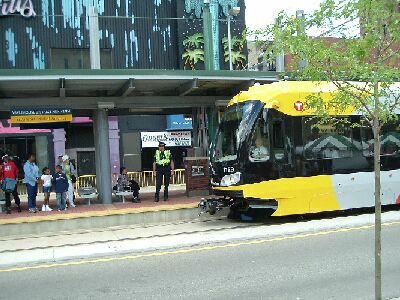
Light Rail Now can be contacted at: Light Rail Now |
Andy inserra is President of the Railroad Club at the University of Minnesota. History It all started back in the early 1970s when the Highway 55 corridor was considered for an eight-lane freeway rather than its current four-lane highway configuration. Local residents and rail transit advocates fought hard to preserve the neighborhoods. They succeeded, and had the land dedicated for the extra lanes set aside for a then-futuristic transit system known as light rail. A new name for an old idea, light rail took over 30 years to begin service in Minneapolis. That new service began 50 years after the last streetcars ran on the Twin Cities Rapid Transit system. The 50th anniversary of the last streetcar trips came just one week before the brand-new light rail system began service.
Trains began service on June 26 of this year, just over three years after ground was broken on the line. Since that date the ridership numbers have steadily grown and have left the folks at Metro Transit "cautiously stunned" at the amazing success so far – especially since only 2/3 of the line is in service, until winter, when the remainder opens! The following are some ridership statistics. Ridership statistics "Rail transit is off to an impressive revival in the Twin Cities" enthused the Minneapolis Star Tribune in a July 11th editorial, commenting on the high ridership and overwhelmingly positive public acceptance. Below are the available statistics for the line in the first two months of operation Daily Ridership in Opening Days
LRT Ridership Week Snapshot - July 5-11
· Early August averages – Weekday averages are still growing and currently are usually between 15,000 and 16,000 riders with some days reaching almost 20,000 riders. · July totals – in July over 462,400 people rode the train. That doubles Metro Transit's projection of 231,400. Fares collected in the first month of operation totaled $360,000, an amount which is roughly $105,000 more than expected. Also note – many people start their trips on the bus and continue it on the train with the free transfers offered all across the metro-area transit systems. · Special events – Vikings fans took the train to the first pre-season game at the Metrodome, boosting August 14's Saturday ridership to 22,075. In comparison, rail ridership averages 16,000 on weekdays. Also – Twins fans have been using the trains to get to the game as well. The popularity of the train for special events and for workers to leave downtown for lunch is a welcome surprise for Metro Transit. Other interesting facts include the following: · 62% of total weekday rides were made during midday and evening. · 38% of total weekday rides were made during rush hours. · 70% of all rides were made at midday, in the evenings or on weekends. · 16,000 = average number of weekday riders (projection was 9,500 daily). · 25,400 = average number of weekend total riders (projection was 6,400 for the two days). · 49 = number of arrests, primarily for drunkenness and disturbing the peace · 31 = number of ticket violations. · 20 = number of gate arms damaged by people stopping too close to the crossing, etc. · 0 = number of collisions with autos, bikes, pedestrians (several vehicles have crashed into gates and other infrastructure, but not trains). The weekday ridership before the entire line is open has been expected to be just over 9,000 riders and it is projected to be 19,000 when the entire line is open. These modest estimates were scoffed at by experts around the country – they advised us to expect more ... and they were right. Future plans With the great success of the line already demonstrated, there are more lines waiting for funds from the state capitol. They are listed below, in order of when they'd be built (at this time): · Central Line – From downtown Minneapolis to the University of Minnesota and into downtown St Paul ... this line would run down University Ave. most of the trip where the packed route 16 and 50 buses run now. Whenever the University is in session, students and staff cram the buses to capacity and a rail line is desperately needed to bring service to a more reliable, frequent, and comfortable level. · Southwest Line – Reaching the fast-growing southwest suburbs from Minneapolis ... where traffic is slow moving and bus ridership grows every year. · Historic Streetcar – Midtown Greenway Line – Following Lake Street in an old rail trench, this line will join the bike and walking trails to connect people to the lakes, Hiawatha Line (at Lake St.), and the western edge of Minneapolis where it also could connect to the Southwest Line. · Commuter Rail – Northstar Line – From Minneapolis to Big Lake and onto St Cloud ... connecting to the Hiawatha Line at a new proposed station north of the Warehouse Station at the Rapid Park site where the Northstar line would end in Downtown. As of early August 2004, there are new funds coming to match the federal dollars about to expire. This is a good sign that this line is about to really get underway. · Red Rock Line – From St Paul to Hastings following the river ... connecting to the Central Line in St Paul at Union Depot. if we build it, they will ride The citizens have shown if we build it they will ride it – now all that is left is to convince the politicians of this fact so the Twin Cities can regain the status it lost 50 years ago as a truly progressive metro area where people can get where they need to be with ease. Thanks to Jennifer Lovaasen and Josh Collins at the HPO for their help with the latest statistics. Light Rail Now! website |
||||||||||||||||||||||||||
|
|
|||||||||||||||||||||||||||